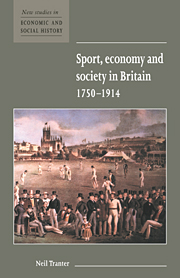4 - A conspiracy of the elites?
Published online by Cambridge University Press: 18 December 2009
Summary
Underlying the ‘revolution’ which occurred in the extent and character of sporting activity during the Victorian and Edwardian eras was a complex mix of forces which made it possible for a new sporting culture to emerge. One of these was rising standards of nutrition which supplied the energy needed for more regular participation in physical recreation (Vamplew, 1988a, 11). A second was the growing availability of land on which to play, itself a combined result of the spaciousness of the new suburbs, the greater provision of public parks and playing fields by local authorities and private philanthropists and, particularly in the case of golf, the falling cost of marginal agricultural land caused by the late nineteenth- century decline in food prices (Allison, 1980: 12; Lowerson, 1989a: 191–2; 1993: 16; Sandiford, 1994: 54). A third was the continued growth of population and urbanisation which further expanded the opportunities for sport entrepreneurship and facilitated the rise of mass spectator sports like boxing, horseracing, pedestrianism and soccer (Cunningham, 1980: 36; Vamplew, 1988a: 13).
Another was the increasing size of the middle-class population – from the elites of business and the professions to the tradesmen and lower-status occupations of clerks and teachers – whose income levels and working experiences were especially conducive to participation in leisure activities (Lowerson, 1993: 5–12). Yet another was the growing ease of communication made possible by rising rates of literacy, the invention of the telegraph and the advent of cheap, mass-circulation newspapers and specialist sports publications.
- Type
- Chapter
- Information
- Sport, Economy and Society in Britain 1750–1914 , pp. 32 - 51Publisher: Cambridge University PressPrint publication year: 1998

